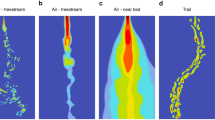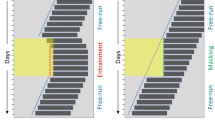Summary
-
1.
The TCG interneurone of the locust integrates information from the wind-sensitive head hairs and the antennae. The cell is rhythmically active in tethered flight and is sensitive to a yaw imposed on the animal in a laminar stream of air — the left TCG is more sensitive to a yaw to the left and vice versa (Figs. 1, 5).
-
2.
Successively waxing over the different windhair fields (fields 1...5) and immobilising the antennae reveals that all these sense organs contribute to the sensitivity of the neurone to the angle of yaw (Figs. 2, 3). There is no mutual inhibition between the right and left TCG (Fig. 4).
-
3.
The cell shows a phasic-tonic reaction when either the resting or the flying animal is subjected to a stepwise yaw. However, the tonic component is stronger when the animal is flying (Fig. 7).
-
4.
During flight the TCG fires rhythmically in bursts synchronised with depressor muscle potentials, i.e., at about the time when the wing is in its top position. Yaw angle is coded by the number of spikes per burst and their timing within the wing-beat cycle. An increase of the TCG activity is correlated with an earlier beginning of the burst (Figs. 8, 9). There is no change in the interspike interval within the TCG burst during a yaw stimulus: the 1st and 2nd interspike intervals remain at an average of about 4 ms (Fig. 9).
-
5.
In straight flight, electric stimulation applied to the right TCG neurone (thus mimicking a yaw to the right) evokes antagonistic time shifts in downstroke muscles, equivalent to those observed in response to an actual right yaw being imposed on the animal (Figs. 10, 11). The results suggest that the TCG is an important pathway in mediating yaw-correcting behaviour.
-
6.
A small resetting of the flight rhythm is produced when the TCG is electrically stimulated during flight (Fig. 13).
Similar content being viewed by others
References
Bacon J, Möhl B (1979) Activity of an identified wind interneurone in a flying locust. Nature 278:638–640
Bacon J, Möhl B (1983) The tritocerebral commissure giant (TCG) wind-sensitive interneurone in the locust. I. Its activity in straight flight. J Comp Physiol 150:439–452
Bacon J, Tyrer NM (1978) The tritocerebral commissure giant (TCG): A bimodal interneurone in the locust,Schistocerca gregaria. J Comp Physiol 126:317–325
Baker PS (1979) The role of forewing muscles in the control of direction in flying locusts. J Comp Physiol 131:59–66
Burrows M (1975) Monosynaptic connexions between wing stretch receptors and flight motorneurons of the locust. J Exp Biol 62:189–219
Camhi JM (1970) Yaw-correcting postural changes in the locust. J Exp Biol 52:519–531
Dagan D, Parnas I (1970) Giant fibre and small fibre pathways involved in the evasive response of the cockroach,Periplaneta americana. J Exp Biol 52:313–324
Gewecke M, Philippen J (1978) Control of the horizontal flight course by air-current sense organs inLocusta migratoria. Physiol Entomol 3:43–52
Horsmann U, Heinzel H-G, Wendler G (1983) The phasic influence of self-generated air current modulation on the locust flight motor. J Comp Physiol 150:427–438
Kien J, Altman JS (1979) Connections of the locust wing tegulae with metathoracic flight motorneurons. J Comp Physiol 133:299–310
Kupfermann I, Weiss KR (1978) The command neuron concept. Behav Brain Sci 1:3–39
Möhl B, Zarnack W (1977) Flight steering by means of time shifts in the activity of the direct downstroke muscles in the locust. Fortschr Zool 24:333–339
Möhl B, Nachtigall W (1978) Proprioceptive input in the locust flight motor revealed by muscle stimulation. J Comp Physiol 128:57–65
Weis-Fogh T (1949) An aerodynamic sense organ stimulating and regulating flight in locusts. Nature 164:873–874
Wendler G (1974) The influence of proprioceptive feedback on locust flight co-ordination. J Comp Physiol 88:173–200
Wendler G (1978) The possible role of fast wing reflexes in locust flight. Naturwissenschaften 65:65
Wohlers DW (1980) Anatomical and physiological studies of the auditory pathway in crickets. Dissertation, Universität München
Zarnack W, Möhl B (1977) Activity of the direct downstrokemuscles ofLocusta migratoria (L.) during steering behaviour in flight. J Comp Physiol 118:215–233
Author information
Authors and Affiliations
Rights and permissions
About this article
Cite this article
Möhl, B., Bacon, J. The tritocerebral commissure giant (TCG) wind-sensitive interneurone in the locust. J. Comp. Physiol. 150, 453–465 (1983). https://doi.org/10.1007/BF00609571
Accepted:
Issue Date:
DOI: https://doi.org/10.1007/BF00609571




